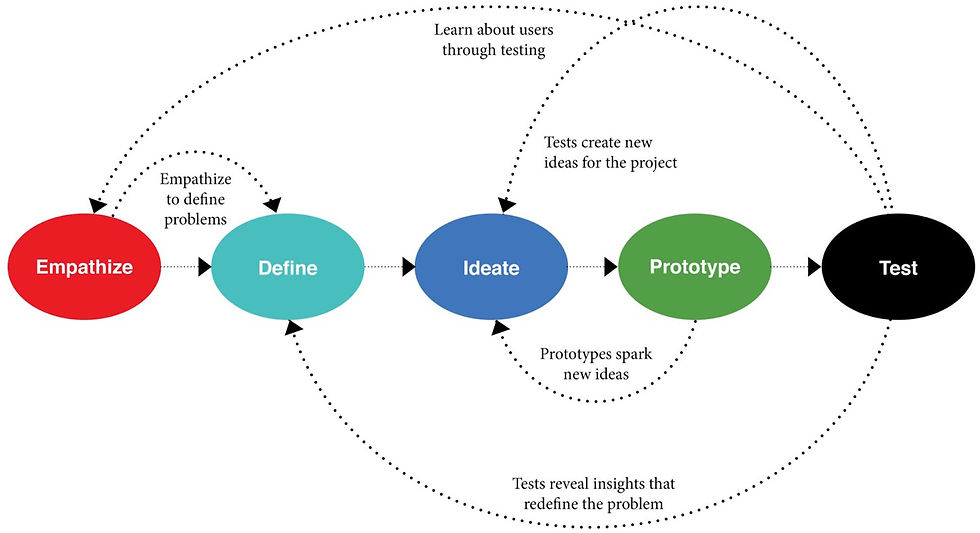Blog 2 - Task 2 - Using Google Jamboard to enhance students' creativity and design thinking skills.
- Pia Malmberg
- Apr 9, 2023
- 3 min read
(Thirdman, 2020)
As teachers, we often try to tell our students to be creative with their answers and solutions. We tell them to think outside of the box and collaborate in teams. What we sometimes forget to do, is to facilitate the space for these students to learn how to develop the skills needed to do so in the first place. We forget that creative thinking is a skill and requires scaffolded opportunities to build higher-order thinking skills. We sometimes forget that for a skill to improve, you must practice the skill many times to become an expert (Aitken, 2019).
(The five common stages of design thinking (Verhulsdonck et al., 2021))
Today, most companies that produce something, use something called design thinking. Design thinking is a problem-solving process that allows its users through a set of steps through a consumer-focused approach to come up with and test solutions for a specific problem. Although the process can seem somewhat linear, the process is anything but linear as it requires the user to reflect, edit, test, redo and much more before a final product can be achieved (Verhulsdonck et al., 2021). Design thinking is social in its nature and requires its user to be flexible, patient, and understanding throughout the process. The goal is to create a product that solves the problem of the client that needs it. Whether you are an engineer, a cleaner, a manager, or a teacher, design thinking skills are almost always going to be needed and as such you could argue that we teachers owe it to our students to facilitate an environment where they can build these skills (Ananda et al., 2023).
(Original Author content from Jamboard)
One such tool is Google Jamboard. Jamboard is an online whiteboard tool that enables and encourages real-time collaboration using shared digital canvases. Through sticky notes, drawings, images and much more, teams can collaborate through brainstorming, sharing ideas, and giving peer feedback. Therefore, enabling students to collaborate in Jamboard could allow students to build these design thinking skills whilst learning the curricular content at the same time.
(Original Author content from Jamboard)
As an example, students in a Stage 6 Earth & Environmental Sciences class can work on their design thinking skills collaboratively in Jamboard by sharing ideas on flood hazards as part of Module 6: Hazards (ACSES102, EES11/12-4) (Australian Curriculum, 2023; NESA, 2018). Here they are initially confronted with scaffolded questions as a whole class, when they later are to work in groups, they can attack a specific issue and come up with creative solutions and reasons why it may or may not work. Should the teacher want to, this could easily be implemented into a depth study by allowing them to use Jamboard as their collaborative creative tool.
Although there are other whiteboard tools out there such as Miro and Stormboard, Jamboard is fully free and allows its users to have more whiteboards working at the same time compared to other whiteboard tools. Furthermore, it is available on web readers as well as iOS and Android devices and its interface is easy to navigate.
Overall, using Jamboard to improve students’ design thinking skills can be an excellent way to ensure that our classrooms allow students to build creative and critical job-applicable skills they can use for their whole lives whilst following the specific syllabus criteria.
References
Aitken, L. (2019, May 01). Teacher perspectives on using project-based learning. Teacher Magazine. https://www.teachermagazine.com/au_en/articles/teacher-perspectives-on-using-project-based-learning
Ananda, L. R., Rahmawati, Y., & Khairi, F. (2023). Critical thinking skills of Chemistry students by integrating design thinking with STEAM-PjBL. Journal of Technology and Science Education, 13(1), 352–367. https://doi.org/10.3926/jotse.1938
Australian Curriculum. (2023, Mar 19). Earth and Environmental Science (Version 8.4) – Unit 4. https://www.australiancurriculum.edu.au/senior-secondary-curriculum/science/earth-and-environmental-science/?unit=Unit+4
NESA. (2018). Module 6: Hazards – Year 12, Stage 6 – Earth and Environmental Science – Course content. NSW Education Standards Authority. https://educationstandards.nsw.edu.au/wps/portal/nesa/11-12/stage-6-learning-areas/stage-6-science/earth-and-environmental-science-2017/content/2072
Sweeney, E. M., Beger, A. W., & Reid, L. (2021). Google Jamboard for virtual anatomy education. The Clinical Teacher, 18(4), 341–347. https://doi.org/10.1111/tct.13389
Thirdman. (2020, September 1). Colleagues planning a business. Pexels. https://www.pexels.com/photo/colleagues-planning-a-business-5257576/
Verhulsdonck, G., Howard, T., & Tham, J. (2021). Investigating the Impact of Design Thinking, Content Strategy, and Artificial Intelligence: A “Streams” Approach for Technical Communication and User Experience. Journal of Technical Writing and Communication, 51(4), 468–492. https://doi.org/10.1177/00472816211041951







Comments